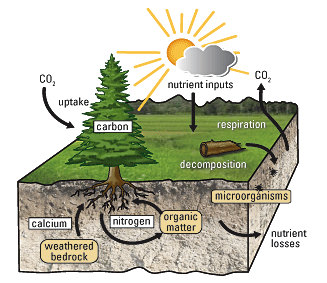| << Chapter < Page | Chapter >> Page > |
To be sure, soil development is not always continual. Geologic events can rapidly bury soils (landslides, glacier advance, lake transgression), can cause removal or truncation of soils (rivers, shorelines) or can cause soil renewal with additions of slowly deposited sediment that add to the soil (wind or floodplain deposits). Biological mixing can sometimes cause soil regression, a reversal or bump in the road for the normal path of increasing development over time.
As the medium for native plant growth, agriculture, building construction, waste disposal, and a pathway for groundwater infiltration, soil plays an important role for many key activities of our society. Soil scientists, agronomists, foresters, plant biologists, land-use planners, engineers, archeologists, and geologists, among others, all consider soil type (composition, texture, structure, density, etc.) in many aspects of their research or work. Below are some examples of the importance of soils in natural plant growth, in agriculture, and related societal issues. The long-term sustainability of soil is vital to both human ecology, even in modern society, and the ecology of our natural surroundings.
Soil plays a key role in plant growth. Beneficial aspects to plants include providing physical support, heat, water, nutrients, and oxygen. Heat, light, and oxygen are also obtained by the atmosphere, but the roots of many plants also require oxygen. Elemental nutrients, dissolved in soil water solution, are derived from soil minerals and organic material (see Figure Soil-Plant Nutrient Cycle ).

Plants mainly obtain nutrients from dissolved soil solutions. Though many aspects of soil are beneficial to plants, excessively high levels of trace metals (either naturally occurring or anthropogenically added) or applied herbicides can be toxic to some plants.
The ratio of solids/water/air in soil is also critically important to plants for proper oxygenation levels and water availability. Too much porosity with air space, such as in sandy or gravelly soils, can lead to less available water to plants, especially during dry seasons when the water table is low. Too much water, in poorly drained regions, can lead to anoxic conditions in the soil, which may be toxic to some plants. Hydrophytic vegetation can handle anoxic conditions and is thus suitable to poorly drained soils in wetland areas.
Several elements obtained from soil are considered essential for plant growth. Macronutrients, including C, H, O, N, P, K, Ca, Mg, and S, are needed by plants in significant quantities. C, H, and O are mainly obtained from the atmosphere or from rainwater. These three elements are the main components of most organic compounds, such as proteins, lipids, carbohydrates, and nucleic acids. Oxygen generally serves as an electron acceptor and is required by roots of many plants. The other six elements (N, P, K, Ca, Mg, and S) are obtained by plant roots from the soil and are variously used for protein synthesis, chlorophyll synthesis, energy transfer, cell division, enzyme reactions, and osmotic or ionic regulation.

Notification Switch
Would you like to follow the 'Sustainability: a comprehensive foundation' conversation and receive update notifications?